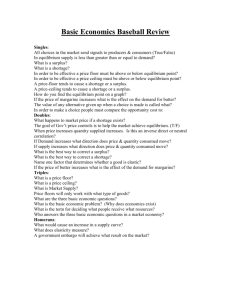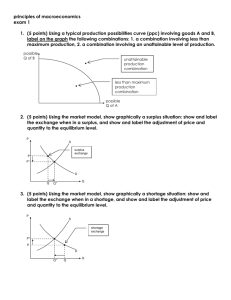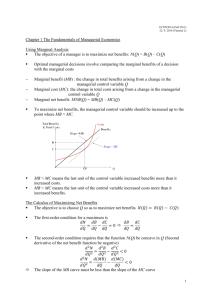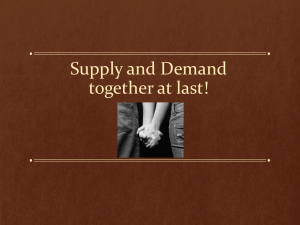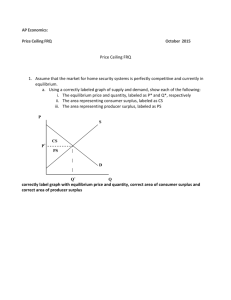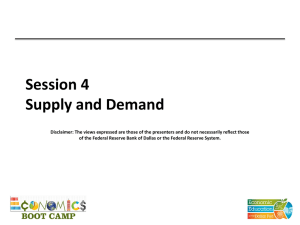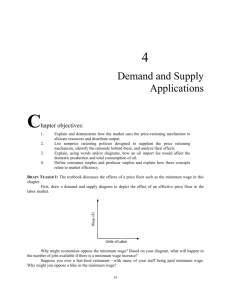Chapter four - Whitman People
advertisement
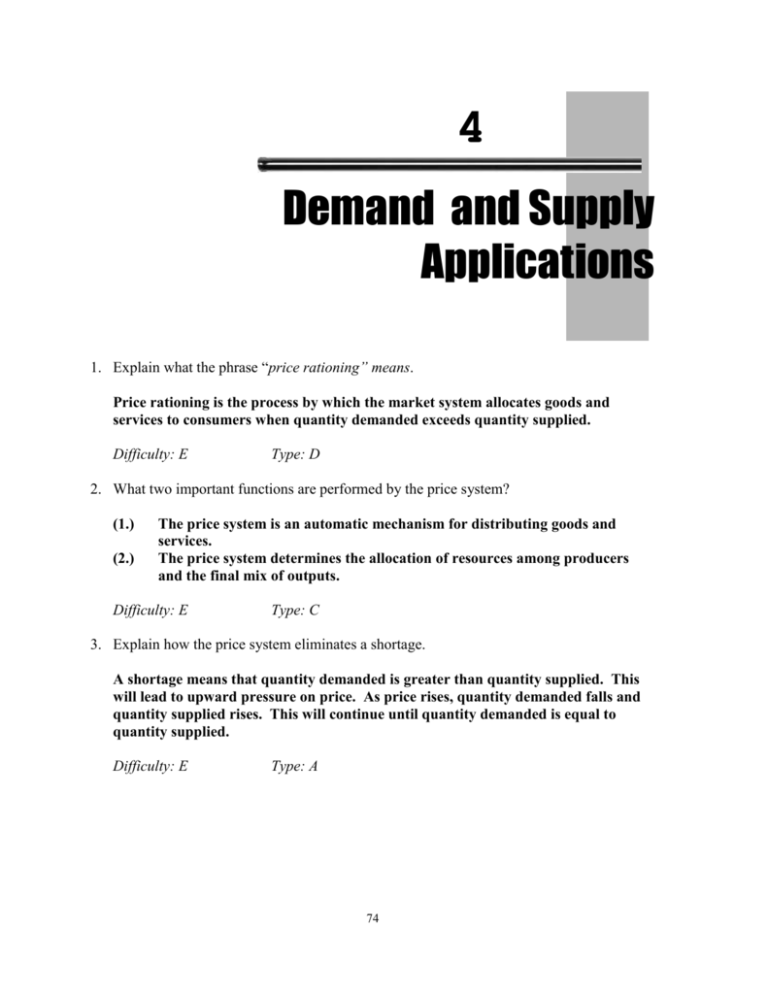
4 Demand and Supply Applications 1. Explain what the phrase “price rationing” means. Price rationing is the process by which the market system allocates goods and services to consumers when quantity demanded exceeds quantity supplied. Difficulty: E Type: D 2. What two important functions are performed by the price system? (1.) (2.) The price system is an automatic mechanism for distributing goods and services. The price system determines the allocation of resources among producers and the final mix of outputs. Difficulty: E Type: C 3. Explain how the price system eliminates a shortage. A shortage means that quantity demanded is greater than quantity supplied. This will lead to upward pressure on price. As price rises, quantity demanded falls and quantity supplied rises. This will continue until quantity demanded is equal to quantity supplied. Difficulty: E Type: A 74 Chapter 4: The Price System, and Demand and Supply 75 4. Why is it true that shortages usually occur mainly when price controls are in effect? In the absence of price controls the shortage usually goes away quickly because prices are bid up to eliminate the excess demand. But with price controls in effect the shortage usually persists. This helps explain why we usually only see long lines in effect when the government imposes a price ceiling like it did during the 1970s socalled gas crisis. Difficulty: M Type: C 5. Most modern countries have prohibitions on the trading of human organs in the market place. What impact do you believe such laws have had on the availability of organs for patients that need them? Furthermore, which people are most likely to be able to obtain the organs that they require and why? Explain the ethical dilemma that is at work that makes the strict application of basic economic principles difficult to put into practice in cases like this. This is likely to have the effect of creating a shortage of organs. The reason is fairly simple. If organs were available for sale perhaps more people might be willing to offer the organs of their deceased family members on the market. Yet at a price of zero there are likely to be many eager customers without the corresponding number of organs available. Making them available for sale in the market might actually eliminate the shortage. The difficulty in applying this basic economic principle is that we do not, as a society, consider human organs to be a commodity that can be bought and sold. There is also the ethical problem that may arise when someone wishes to “hold out” for more money with an eager and willing patient who perhaps cannot “afford” the price. However, even under a system where organs can be legally traded there may be ways for richer patients to get around the rules by making donations to hospitals in a transparent attempt to influence their decision. Difficulty: D Type: C 6. Colleges and universities often do not pay salaries that are market-driven. For example, it is typical for a history professor to make the same as an economics professor. What kinds of problems are likely to result from this kind of a pay scale? 76 Test Item File 3: Principles of Macroeconomics If the salary for the history professor is above the market-clearing level that he or she is likely to earn working anywhere else than that is going to result in an excess of applicants vis-à-vis the number of available positions (i.e. an excess supply of labor). In addition, if the salary paid to economists is lower than the going rate that economists could earn in the private sector then that will lead to a shortage of economics professors (i.e. and excess demand for labor). Difficulty: D Type: C 7. The rash of hurricanes that pelted the Gulf Coast in 2005 resulted in a large decline in gasoline production as many offshore rigs were shut down and many refineries were taken off line while waiting out the hurricane. The decrease in supplies of gasoline led to a run up in prices. Many voters clamored for relief by calling on their congressman and senators to enact temporary price controls. Analyze the impact on the gasoline market that would have transpired had politicians actually headed the calls by voters to impose price controls on gasoline. If temporary controls had been put into effect the likely impact on the market would have been to create a shortage of gasoline. Put simply, this would have resulted in long lines at gas stations and other means of rationing gas as customers attempt to look for ways around the price control. Difficulty: M Type: C 8. Assume that the government of the state of New Jersey has determined that a large number of injuries and deaths have occurred as a result of accidents involving the installation and repairs of electrical equipment at private residences. In reaction to this problem the state assembly decided to pass a law which made a requirement that all certified electricians take and pass a tougher state licensing examination. Analyze the impact that this law is likely to have on the market for electricians and explain why safety may not necessarily improve. If the state licensing examination becomes more difficult it is likely that there will be fewer authorized and certified electricians in the state of New Jersey. As a result this reduction in supply will lead to higher wages for those who do qualify. The result however may lead more homeowners to perform electrical work themselves which might wipe out or more than wipe out the positive impact of having more highly qualified electricians performing work at private residences. Difficulty: D Type: C 9. Explain how low-skilled workers might actually be made worse off from a minimum wage law in terms of working conditions and job training. In addition, what might be the long-run impact on wages and earnings? Chapter 4: The Price System, and Demand and Supply 77 Essentially employers are not being allowed to offer lower wages to workers in exchange for more on-the-job training. Therefore, it is at least reasonable to assume that in the face of having to pay higher wages per hour that firms may simply react by providing less training. In the end this may actually have the effect of making workers less productive than they might otherwise be and lead to a reduction in lifetime wages and earnings. Difficulty: D Type: C 10. Suppose you came across the following headline in a story of a daily newspaper: “Automobile prices are so high right now that there must be a shortage. As a consequence not everyone who needs an automobile will be able to buy one.” Is this statement correct? First of all we have to conclude that all buyers who wish to buy automobiles at the prevailing prices will be able to do so. There will of course be others who are simply unwilling or unable to pay the current price. Secondly, we cannot say that there is a shortage at the current price. If there were then the price would simply rise to choke of the excess demand. Difficulty: M Type: C 11. Explain how the price system eliminates a surplus. A surplus means that quantity demanded is less than quantity supplied. This will lead to downward pressure on price. As price falls, quantity demanded rises and quantity supplied falls. This will continue until quantity demanded is equal to quantity supplied. Difficulty: E Type: A 12. When is the price of a product demand determined? The price of a product is demand determined when the product is in fixed supply. This means that the price of the product is determined solely by the amount that the highest bidder (or bidders) is willing to pay. Difficulty: E Type: D 13. What reasons do governments often give to justify the decision to not allow price to ration goods? 78 Test Item File 3: Principles of Macroeconomics (1.) (2.) (3.) Price gouging is bad. Income is unfairly distributed. Some items are necessities and thus everyone should be able to afford them. Difficulty: E Type: F 14. List some types of non-price rationing systems. (1.) (2.) (3.) Queuing. Favored customers. Rationing coupons. Difficulty: E Type: F 15. Suppose that the equilibrium rent for a two-bedroom apartment in downtown Chicago is $900 per month. The city council decides to place a price ceiling on apartments and will not allow landlords to charge more than $700 per month. Draw this situation using a graph. Make sure that you show the original equilibrium and the effect of the price ceiling on the market. What will happen in this market? There will be a shortage of apartments because quantity demanded (QD) is greater than quantity supplied (QS). Rent Supply 900 Price ceiling 700 Demand QS Difficulty: E Type: A QD Quantity of apartments Chapter 4: The Price System, and Demand and Supply 79 16. Suppose that the equilibrium price of a gallon of gas is $1.40 per gallon. The government decides to place a price ceiling on gasoline and will not allow sellers to charge more than $1.50 per gallon. Draw this situation using a graph. Make sure that you show the original equilibrium and the effect of the price ceiling on the market. What will happen in this market? There will be no effect of this price ceiling on the market. If sellers try to charge a price of $1.50 per gallon, quantity demanded (QD) would be lower than quantity supplied (QS). This means that there would be a surplus. Because the price ceiling is a maximum price, it does not prevent the price from falling as it would in this case. Therefore, the price of gasoline will remain $1.40 per gallon. Price Supply 1.50 Price ceiling 1.40 Demand QD Difficulty: E QS Quantity of gasoline Type: A 17. If ration coupons are used to determine who gets the products available, what happens if the government allows individuals to trade them? The result is very similar to a system of price rationing. The price of the rationed good will rise to the level it would have been in a free market. Difficulty: M Type: C 18. What is a price ceiling? A price ceiling is a maximum price that sellers can charge for a product. Difficulty: E Type: D 80 Test Item File 3: Principles of Macroeconomics 19. Suppose the demand for bananas increases. Explain how the price of bananas adjusts after the increase in demand. If the demand for bananas rises, a shortage is created at the original equilibrium price. This means there will be upward pressure on price. As price rises, quantity demanded falls and quantity supplied increases until the two are equal. Difficulty: M Type: A 20. The U.S. domestic market for T-shirts is shown below. Price Supply 8 Demand Quantity of T-shirts The world price of T-shirts is $5.00 and the U.S. can buy all of the T-shirts it wants at that price. Show the world price on the graph above. Will the U.S. import or export T-shirts? How many will be traded? If the world price of T-shirts is $5.00, the U.S. will import T-shirts. They will import (QD - QS) T-shirts. Price Supply 8 5 World Price Demand QS QD Quantity of T-shirts Chapter 4: The Price System, and Demand and Supply 81 Difficulty: E Type: A 21. How does price serve as a signal to resource owners? When consumers decide that a good or service is more appealing than before, demand rises. This creates a shortage at the original equilibrium price, putting upward pressure on price. The higher price increases the amount of profit firms can earn, and provides them with an incentive to produce more. Thus, resource prices are bid up to attract more resources to the firms. The end result is a movement of resources into the industry. Difficulty: M Type: A 22. The U.S. market for rice is shown below. Supply Price 20 World Price 12 Demand QS QD Quantity of rice (bushels) The world price of rice is $12 per bushel and the U.S. can buy all of the rice that it wants at that price. The government places a tax on imported rice of $2 per bushel. Show the effect of this tax on the graph above. What will happen to the amount of rice the U.S. imports? The tax will increase the world price of rice to $14. Thus, the U.S. will import less rice. 82 Test Item File 3: Principles of Macroeconomics Supply Difficulty: M Type: A 23. The U.S. government has two different methods to deal with illegal drug use. First, the government has tried a “war on drugs”, with the idea of keeping illegal drugs out of the country. Second, the “Just say no” campaign has been used to make individuals more aware of the harmful effects of drugs. Use supply and demand to analyze the effects of these two separate policies. The “war on drugs” leads to a reduced supply of drugs. The decrease in supply pushes the equilibrium price up and the equilibrium quantity down. The “Just say no” campaign is designed to reduce the demand for drugs. This will lower both the equilibrium price and quantity. Difficulty: M Type: A 24. Explain what will happen when the government imposes a maximum price that is above the market equilibrium price. Why is this true? The maximum price will have no impact on the market. This is true because the price ceiling will only have an impact when the market equilibrium price is above it. Firms and consumers will otherwise not change their behavior. Difficulty: M Type: A Chapter 4: The Price System, and Demand and Supply 83 25. Explain what will happen when the government imposes a minimum price that is below the market equilibrium price. Why is this true? The minimum price will have no impact on the market. This is true because the price floor will only have an impact when the market equilibrium price is below it. Firms and consumers will otherwise not change their behavior. Difficulty: M Type: A 26. Suppose that Bill is a big movie buff and enjoys renting movies from the local video rental outlet. Assume that he is willing to pay $5 for the first movie he rents for the weekend but would only pay $4 for a second and still only $3 for a third movie. If the video rental franchise charges $3.50 per movie what will Bill’s consumer surplus be and why? Assume now that the video rental franchise now has a new package deal in which it offers to rent three movies to customers at a price of $9.00 would Bill be interested? How much consumer surplus would he enjoy now? What is the maximum price that the video rental franchise could charge and still make Bill interested in the package deal? Bill will enjoy a consumer surplus of $2.00. He’ll rent the first movie and enjoy a surplus of $1.50 ($5.00 - $3.50) and he’ll rent the second movie and enjoy a surplus of $.50 ($4.00 - $3.50). He will not rent the third movie since this will result in negative consumer surplus. If the video rental franchise offers a package deal for $9.00 Bill will take it. The reason is that his consumer surplus will be $3.00 ($5 + $4 + $3 - $9). The maximum price that could be charged for the package deal would be one in which the consumer surplus is the same for Bill as it would be if he had to pay for each of the movies separately. Since the $9 price leaves him with a consumer surplus of $3 it must be that $10 would be the maximum that he would be willing to pay since that deal still provides him with a $2 surplus. Difficulty: D Type: C 27. Consumers are often bewildered by the different array of choices, plans and prices that are offered by companies offering cell phone service. Explain in terms of consumer surplus why this makes sense from both the company’s perspective and that of the consumer. Consumers all have different ability and willingness to pay. If companies knew what the willingness to pay was for any particular consumer it would simply charge them the highest price that they could get away with. The truth is that this willingness to pay is only known by the consumer. If only one plan and price were offered many consumers may elect to subscribe to cell phone service and many may not. By offering different plans and prices it allows consumers to be able to choose the plan that gives them the greatest amount of consumer surplus. This in turn allows the firm to serve more customers and to make more profit. Difficulty: D Type: C

